 W
WThe Commodore 64, also known as the C64 or the CBM 64, is an 8-bit home computer introduced in January 1982 by Commodore International. It has been listed in the Guinness World Records as the highest-selling single computer model of all time, with independent estimates placing the number sold between 12.5 and 17 million units. Volume production started in early 1982, marketing in August for US$595. Preceded by the Commodore VIC-20 and Commodore PET, the C64 took its name from its 64 kilobytes (65,536 bytes) of RAM. With support for multicolor sprites and a custom chip for waveform generation, the C64 could create superior visuals and audio compared to systems without such custom hardware.
 W
WThis article is about the various external peripherals of the Commodore 64 home computer. Due to the backwards compatibility of the Commodore 128, most peripherals will work on that system, as well. There's some compatibility with the VIC-20 and PET too.
 W
W1541 Ultimate is a peripheral, primarily an emulated floppy disk and cartridge emulator based on the FPGA Xilinx XC3S250E, for the Commodore 64 home computer. It became available in 2008.
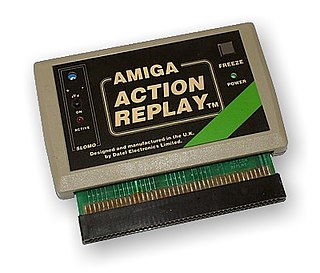 W
WAction Replay is the brand name of a cheating device created by Datel. The Action Replay is available for many gaming systems including the Nintendo DS, Nintendo DSi, Nintendo 3DS, PlayStation Portable, PlayStation 2, GameCube, Game Boy Advance, and the Xbox.
 W
WThe C-One is a single-board computer (SBC) created in 2002 as an enhanced version of the Commodore 64, a home computer popular in the 1980s. Designed by Jeri Ellsworth, a self-taught designer, and Jens Schönfeld from Individual Computers, who manufactured the boards themselves, the C-One has been re-engineered to allow cloning of other 8-bit computers.
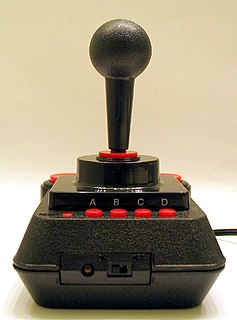 W
WThe C64 Direct-to-TV, called C64DTV for short, is a single-chip implementation of the Commodore 64 computer, contained in a joystick, with 30 built-in games. The design is similar to the Atari Classics 10-in-1 TV Game. The circuitry of the C64DTV was designed by Jeri Ellsworth, a computer chip designer who had previously designed the C-One.
 W
Wcc65 is a cross development package for 65(C)02 systems, including a macro assembler, a C cross compiler, linker, librarian and several other tools.
 W
WChess 7.0 is a 1982 video game published by Odesta.
 W
WThe RAMLink was one of several RAM expansion products made by Creative Micro Designs (CMD) for Commodore's C64/128 home computers. The RAMLink was intended as a third-party alternative, successor and optionally companion to Commodore's own 17xx-series REU RAM expansion cartridges.
 W
WThe Commodore 64 Games System is the cartridge-based home video game console version of the popular Commodore 64 home computer. It was released in December 1990 by Commodore into a booming console market dominated by Nintendo and Sega. It was only released in Europe and was a considerable commercial failure.
 W
WThe Commodore 65 is a prototype computer created at Commodore Business Machines in 1990–1991. It is an improved version of the Commodore 64, and it was meant to be backwards-compatible with the older computer, while still providing a number of advanced features close to those of the Amiga.
 W
WThis article is about the various external peripherals of the Commodore 64 home computer. Due to the backwards compatibility of the Commodore 128, most peripherals will work on that system, as well. There's some compatibility with the VIC-20 and PET too.
 W
WThe Commodore 1541 is a floppy disk drive which was made by Commodore International for the Commodore 64 (C64), Commodore's most popular home computer. The best-known floppy disk drive for the C64, the 1541 is a single-sided 170-kilobyte drive for 5¼" disks. The 1541 directly followed the Commodore 1540.
 W
WThe Commodore 1570 is a 5¼" floppy disk drive for the Commodore 128 home/personal computer. It is a single-sided, 170 kB version of the Commodore 1571, released as a stopgap measure when Commodore International was unable to provide sufficient quantities of 1571s due to a shortage of double-sided drive mechanisms. Like the 1571, it can read and write both GCR and MFM disk formats. The 1570 utilizes a 1571 logic board in a cream-colored original-1541-like case with a drive mechanism similar to the 1541's except that it was equipped with track-zero detection. Like the 1571, its built-in DOS provides a data burst mode for transferring data to the C128 computer at a faster speed than a 1541 can. Its ROM also contains some DOS bug fixes that didn't appear in the 1571 until much later. The 1570 can read and write all single-sided CP/M-format disks that the 1571 can access.
 W
WThe Commodore 1571 is Commodore's high-end 5¼" floppy disk drive. With its double-sided drive mechanism, it has the ability to use double-sided, double-density (DS/DD) floppy disks natively. This is in contrast to its predecessors, the 1541 and 1570, which can fully read and write such disks only if the user manually flipped them over to access the second side. Because flipping the disk also reverses the direction of rotation, the two methods are not interchangeable; disks which had their back side created in a 1541 by flipping them over would have to be flipped in the 1571 too, and the back side of disks written in a 1571 using the native support for two-sided operation could not be read in a 1541.
 W
WThe Commodore 1581 is a 3½-inch double-sided double-density floppy disk drive that was released by Commodore Business Machines (CBM) in 1987, primarily for its C64 and C128 home/personal computers. The drive stores 800 kilobytes using an MFM encoding but formats different from the MS-DOS, Amiga, and Mac Plus formats. With special software it's possible to read C1581 disks on an x86 PC system, and likewise, read MS-DOS and other formats of disks in the C1581, provided that the PC or other floppy handles the "720 kB" size format. This capability was most frequently used to read MS-DOS disks. The drive was released in the summer of 1987 and quickly became popular with bulletin board system (BBS) operators and other users.
 W
WThe Commodore serial IEEE-488 bus, is Commodore's interface for primarily magnetic disk data storage and printers for the Commodore 8-bit home/personal computers, notably the VIC-20, C64, C128, Plus/4, C16 and C65.
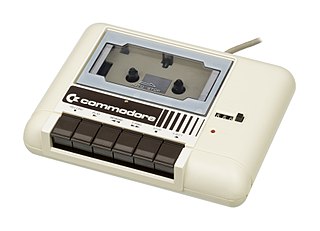 W
WThe Commodore 1530 (C2N) Datasette, later also Datassette, is Commodore's dedicated magnetic tape data storage device. Using compact cassettes as the storage medium, it provides inexpensive storage to Commodore's 8-bit home/personal computers, notably the PET, VIC-20, and C64. A physically similar model, Commodore 1531, was made for the Commodore 16 and Plus/4 series computers.
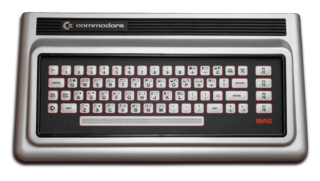 W
WThe Commodore MAX Machine, also known as Ultimax in the United States and Canada and VC-10 in Germany, is a home computer designed and sold by Commodore International in Japan, beginning in early 1982, a predecessor to the popular Commodore 64. The Commodore 64 manual mentions the machine by name, suggesting that Commodore intended to sell the machine internationally; however, it is unclear whether the machine was ever actually sold outside Japan. It is considered a rarity.
 W
WCommodore OS was a free-to-download Linux distribution developed by Commodore USA and intended for Commodore PCs. The distribution was based on Linux Mint, available only for x86-64 architectures, and used the GNOME 2 desktop environment. The first public beta version was released on 11 November 2011. It has been continually updated through Commodore OS Vision 0.8 Beta and never came out of beta phase. 1.0 did come out of Beta and was released on DistroWatch.com.
 W
WCommodore's RAM Expansion Unit (REU) range of external RAM add-ons for their Commodore 64/128 home computers was announced at the same time as the C128. The REUs came in three models, initially the 1700 (128 KB) and 1750, and later the 1764.
 W
WThe Commodore SX-64, also known as the Executive 64, or VIP-64 in Europe, is a portable, briefcase/suitcase-size "luggable" version of the popular Commodore 64 home computer and the first full-color portable computer.
 W
WCompunet was a United Kingdom based interactive service provider, catering primarily for the Commodore 64 but later for the Commodore Amiga and Atari ST. It was also known by its users as CNet.
 W
WCreative Micro Designs (CMD) was founded in 1987 by Doug Cotton and Mark Fellows. It is a computer technology company which originally developed and sold products for the Commodore 64 and C128 8-bit personal computers. After 2001 it sold PCs and related equipment.
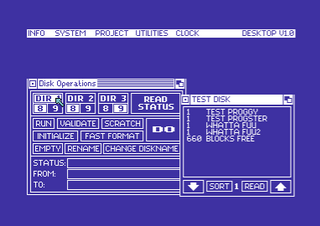 W
WThe Final Cartridge III was a popular extension cartridge which was created for the Commodore 64 and Commodore 128, produced by the Dutch company Riska B.V. Home & Personal Computers. It offered a fast loader, increasing the speeds of the disk drive, and a freezer, allowing the program execution to be stopped to be resumed later.
 W
WThe Magnum Light Phaser is a light gun created in 1987 for the ZX Spectrum computer. A version was also released for the Commodore 64/128. It was Amstrad's last peripheral for the video game console. The Magnum Light Phaser in many ways resembles the Light Phaser, the Sega Master System light gun, released in 1986. It was a Sinclair-branded Far Eastern product which was included in promotional bundles such as the "James Bond 007 Action Pack", along with a small number of lightgun-compatible games.
 W
WThe MOS Technology 6510 is an 8-bit microprocessor designed by MOS Technology. It is a modified form of the very successful 6502. The 6510 was only widely used in the Commodore 64 (C64) home computer and its variants.
 W
WThe MOS Technology 8502 was an 8-bit microprocessor designed by MOS Technology and used in the Commodore 128 (C128). Based on the MOS 6510 that was used in the Commodore 64 (C64). It was manufactured using HMOS process, which allowed it to have higher transistor density, and thus lower cost, while dissipating less heat. The 8502 allowed the C128 to run at double the clock rate of the C64 with some limitations.
 W
WThe 8563 Video Display Controller (VDC) was an integrated circuit produced by MOS Technology. It was used in the Commodore 128 (C128) computer to generate an 80-column RGB video display, running alongside a VIC-II which supported Commodore 64-compatible graphics. The DCR models of the C128 used the later and more technically advanced 8568 [D]VDC controller.
 W
WThe MOS Technology 8568 Video Display Controller (VDC) was the graphics processor responsible for the 80 column or RGBI display on D[CR] models of the Commodore 128 personal computer. In the Commodore 128 service manual, this part was referred to as the "80 column CRT controller." The 8568 embodied many of the features of the older 6545E monochrome CRT controller plus RGBI color.
 W
WThe 6526/8520 Complex Interface Adapter (CIA) was an integrated circuit made by MOS Technology. It served as an I/O port controller for the 6502 family of microprocessors, providing for parallel and serial I/O capabilities as well as timers and a Time-of-Day (TOD) clock. The device's most prominent use was in the Commodore 64 and Commodore 128(D), each of which included two CIA chips. The Commodore 1570 and Commodore 1571 floppy disk drives contained one CIA each. Furthermore, the Amiga home computers and the Commodore 1581 floppy disk drive employed a modified variant of the CIA circuit called 8520. 8520 is functionally equivalent to the 6526 except for the simplified TOD circuitry.
 W
WThe MOS Technology 6581/8580 SID is the built-in programmable sound generator chip of Commodore's CBM-II, Commodore 64, Commodore 128 and Commodore MAX Machine home computers. It was one of the first sound chips of its kind to be included in a home computer prior to the digital sound revolution.
 W
WThe VIC-II, specifically known as the MOS Technology 6567/8562/8564, 6569/8565/8566 (PAL), is the microchip tasked with generating Y/C video signals and DRAM refresh signals in the Commodore 64 and C128 home computers.
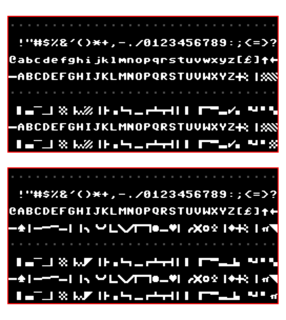 W
WPETSCII, also known as CBM ASCII, is the character set used in Commodore Business Machines (CBM)'s 8-bit home computers, starting with the PET from 1977 and including the C16, C64, C116, C128, CBM-II, Plus/4, and VIC-20.
 W
WPunter is a protocol for file transfer developed in the 1980s by Steve Punter. There are various types of Punter such as PET Transfer Protocol (PTP), C1 and C2.
 W
WScene World Magazine is a disk magazine for the Commodore 64 home computer. The magazine has been released regularly since February 2001.